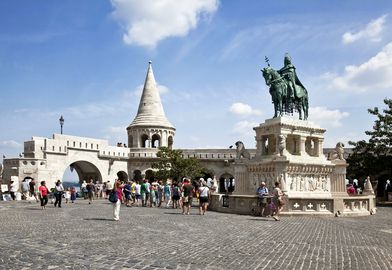

For the best panoramic views of Hungary’s Parliament building and the Pest banks of the Danube, Fisherman’s Bastion has yet to be rivalled; this is definitely the place to go to get your perfect photo shots. This stunning Neo-Gothic style panoramic viewing terrace is one of the top attractions in Budapest, and for very good reason.
But why the strange name? Well, there are a few popular theories that you will hear floating around, some say that Fisherman’s Bastion was named after the fishermen who lived below the walls (in an area known as Fishtown to locals) who protected the walls during times of warin the Middle ages. Others agree partly with this theory in as much as it was named after the fishermen, but they were not guardians as such. Another theory is that it was simply named after the castle’s fish market which was held next to Matthias Church.
Whatever the reason for the name, the fact remains that Fisherman’s Bastion boasts one of the most splendid panoramic views of the Danube, Parliament, Margaret Island and Gellert Hill. It is often cited as one of the best UNESCO World Heritage views in the world.
Built between 1895 and 1902, Fisherman’s Bastion was designed by the architect FrigyesSchulek who was also responsible for the restoration of Matthias Church. It was built in the main to celebrate the 1000th birthday of the Hungarian State and this is why the architectural style is reminiscent of early medieval times and complements that of Matthias Church, which was also being restored around this time. Schulek was influenced by Romanesque and Gothic architecture and this can be seen quite clearly in the overall style.
Fisherman’s Bastion certainly resembles a scene out of a magical fairy tale with its seven towers, each representing one of the sevenHungarian Chieftains who brought their tribes to the Carpathian Basin and founded Hungary in 895 AD.
Perhaps, apart from the towers themselves, the most prominent figure of Fisherman’s Bastion is the bronze statue of the first King of Hungary; Stephen (or Istvan) mounted on a horse. He reigned from 1000 to 1038 and to this date St Stephen’s Day is celebrated in Hungary on 20th August each year.
The current day Fisherman’s Bastion was intentionally built as a viewing terrace to complement Matthias Church as Buda Castle was no longer considered a military fort. What’s more, the Bastion is more of a representation of history as opposed to an absolute replica of the walls that stood here before. Certainly the castle had seen many a siege, having been conquered by the Turks in the 16th century and reclaimed by the Austrians, its walls back then certainly needed to be strong and would have been much thicker than they are now.
During the construction of Fisherman’s Bastion, another gem was found, a medieval underground chapel; St Michel’s Chapel which you can now also visit.
The building of the Fisherman’s Bastion not only provided the perfect accompaniment to Matthias Church and its surrounds, but also opened up easy access to the stunning views of the Danube which before its construction were more difficult to benefit and fully enjoy.
Although the view is superb, naturally over time there have been changes. Probably the most significant and controversial was the construction of the 5 star Hilton Castle District Hotel built in the 1970’s. The design divided opinion especiallythe side facing the river which was considered by many people to be too modern looking and incongruent with its historic surroundings. Furthermore, its construction meant that the old former Jewish Monastery which had long stood in its place had to be destroyed.